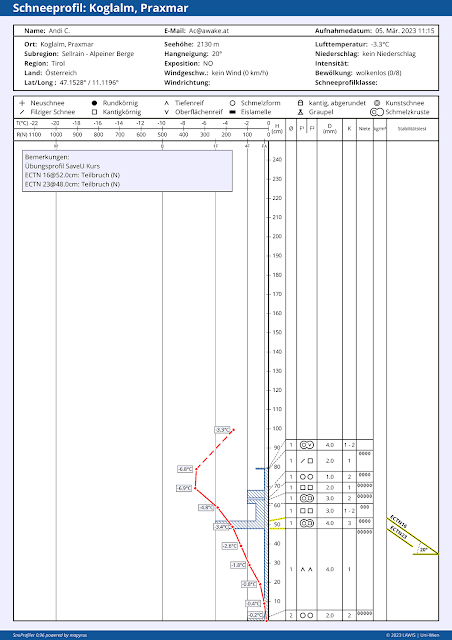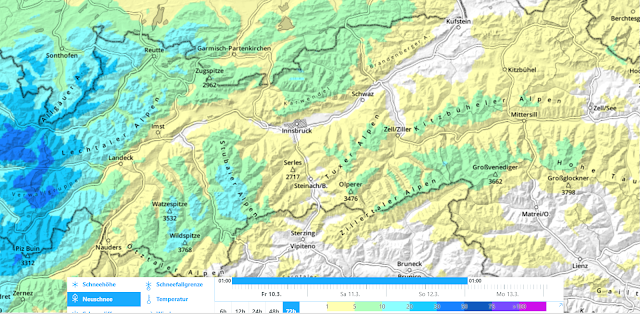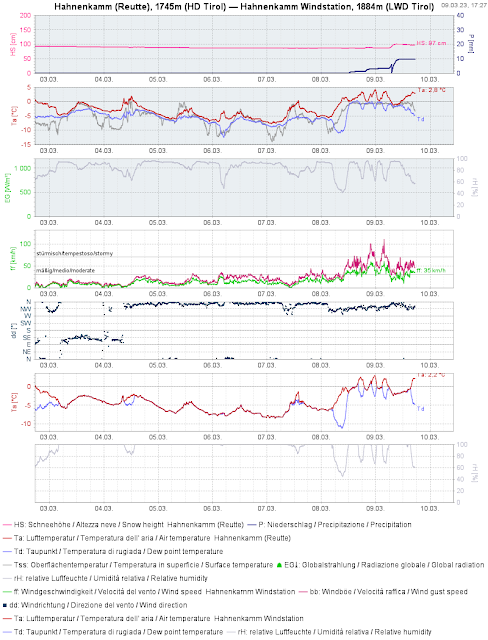The overall picture
Springtime is well known to have a few surprises up its sleeve. Accordingly, the snowpack can moisten thoroughly (at least the surface layer) within the shortest imaginable time due to diffuse radiation, increased air moisture and higher temperatures. This, in turn, transforms the slab. Or else, water seeps down into the snowpack and raises the proneness to triggering. Contrarily, it is also possible that an inflow of dry, cold air masses rapidly stabilize a moist snowpack. What we are trying to point out is this: in spring it is especially important to train a sharp eye on the weather and its effects on the snowpack, and then react accordingly.
Still quite favorable avalanche conditions by and large – but avalanches are possible nonetheless
During the last 10 days, moderate-to-low avalanche danger prevailed in Tirol, and this assessment continues today (10 March 2023). The snowpack is highly irregular, frequently quite stable.
.jpg) |
| During the last few weeks, extremely steep terrain was often the playground of winter sports enthusiasts. East Tirol (photo: 09.03.2023) |
Nevertheless, we still pinpoint weak layers which can be triggered by winter sports enthusiasts. This is the case mostly in shady terrain above 2200m, increasingly frequent also on east-facing ridgeline slopes at heightened altitudes. Most of the recent avalanche triggerings stemmed from the persistent weak layer we all know about (with weak layers near ground level). The theme was treated in detail in our last blog. Cold on warm (dp.4) has been repeatedly observed in backcountry terrain. This layer turned ugly only in very isolated cases, we believe, most likely on shady slopes at 2100 to 2400m.
_bearbeitet.jpg) |
| Avalanche triggering Blankenstein near Innervillgraten, eastern Deferegger Alps. 04.03.2023 2400m, NE, 40°. One person suffered a knee injury. |
.jpg) |
| The weak layer beneath a thin melt-freeze crust was generated by dp.4 2340m, NW, 36°. Eastern Lechtal Alps (photo: 03.03.2023) |
 |
| Profile for above photo. Stability tests with complete fractures (03.03.2023) |
Diffuse radiation
Today (9 March 2023) we observed how surface-near layers in shady terrain at 2200m can become moistened by diffuse radiation and thereby become denser. A snowpack which to date is quite low in internal tension and a loose fundament can thereby have the prerequisites for generating a slab (slab plus weak layer). Over compressed space the danger of slab avalanches can increase correspondingly.
.jpg) |
| When radiation is diffuse, high amounts of energy are absorbed by the snowpack. Silvretta (photo: 08.03.2023) |
 |
| In this profile the snowpack is still dry. Moisture from diffuse radiation can compress the density of the surface-near layers, thereby making slab triggerings possible. (profile from 05.03.2023) |
Diffuse radiation can also destroy the near-surface weak layers. This is important because surface hoar has formed massively in recent weeks. This was often due to the tenacious fog and nocturnal outgoing radiation. In some places the surface hoar was generated due to the Nigg Effect.
 |
| Reports of surface hoar which reached us during the last 10 days (inc. 09.03.2023) |
.jpg) |
| Surface hoar in northern Zillertal Alps (photo: 04.03.2023) |
.jpg) |
| Ridgeline surface hoar due to Nigg Effect. Kaunergrat (photo: 04.03.2023) |
The surface hoar had a tough time of it: on the one hand, strong westerly winds; on the other, diffuse radiation on 8 and 9 March which destroyed a great deal of it. Nevertheless, some of it survived...
What’s coming?
Central Europe lies in the path of a powerful westerly air current according to Geosphere Austria. Thus, frontal systems will be repeatedly transported to Austria. Between Friday, 10.03 and Saturday 11.03, some snowfall is expected, most in western regions, about 20 cm is anticipated, more from place to place. The snowfall level is expected to descend to low lying areas. Subsequently, variable conditions will reign, including winds and milder temperatures.
 |
| 72h Neuschnee zwischen 10.03. und 12.03. für Tirol |
Avalanche danger levels are not expected to change significantly. Following the snowfall on 10-12 March, we anticipate increasingly frequent loose-snow avalanches.
.jpg) |
| Fresh loose-snow avalanches in the Silvretta from 09.03.2023 |
.jpg) |
| In the regions where snowfall has been heaviest, fabulous powder is often to be enjoyed for a short time following the precipitation. (photo: 09.03.2023) |
